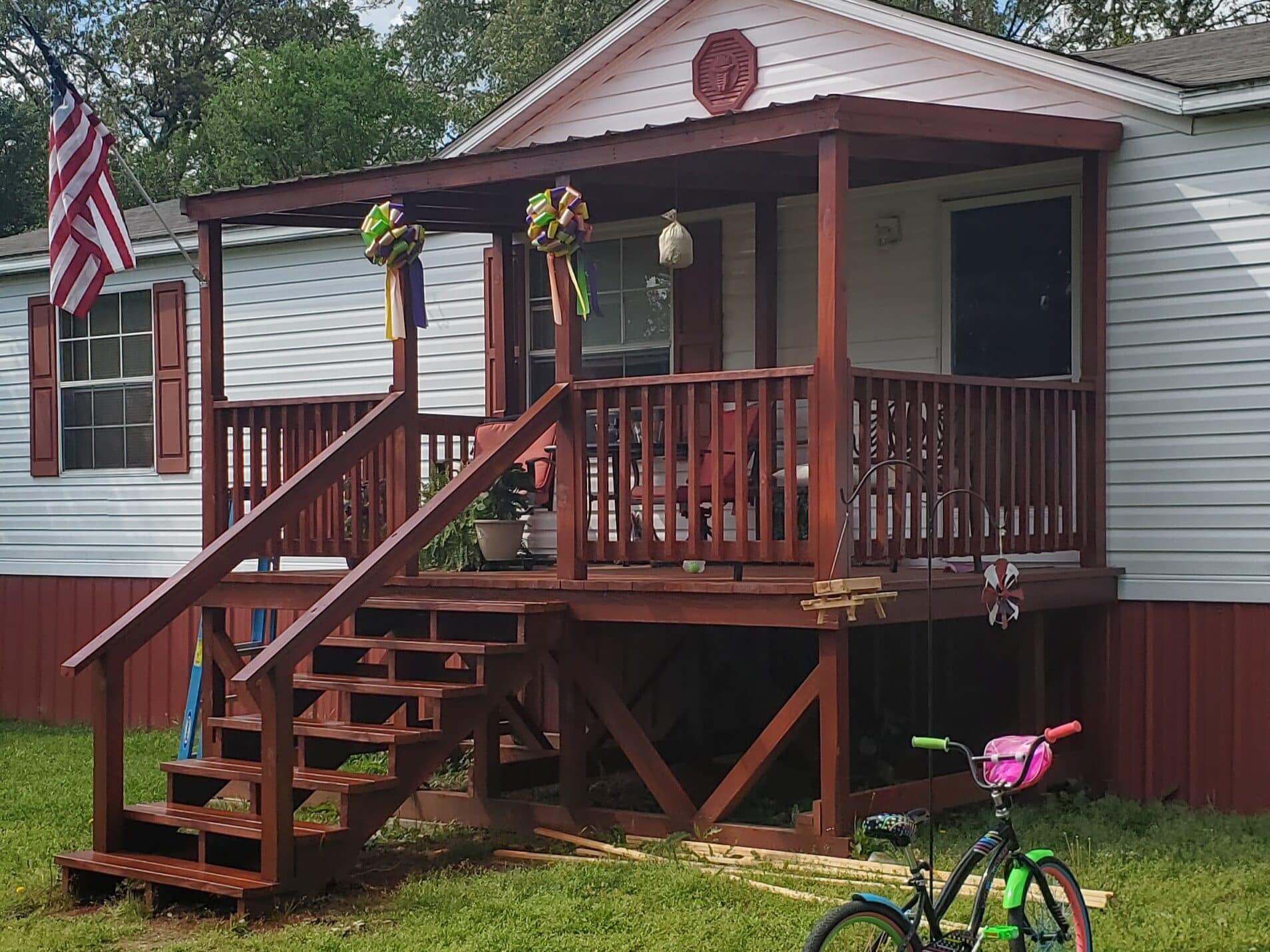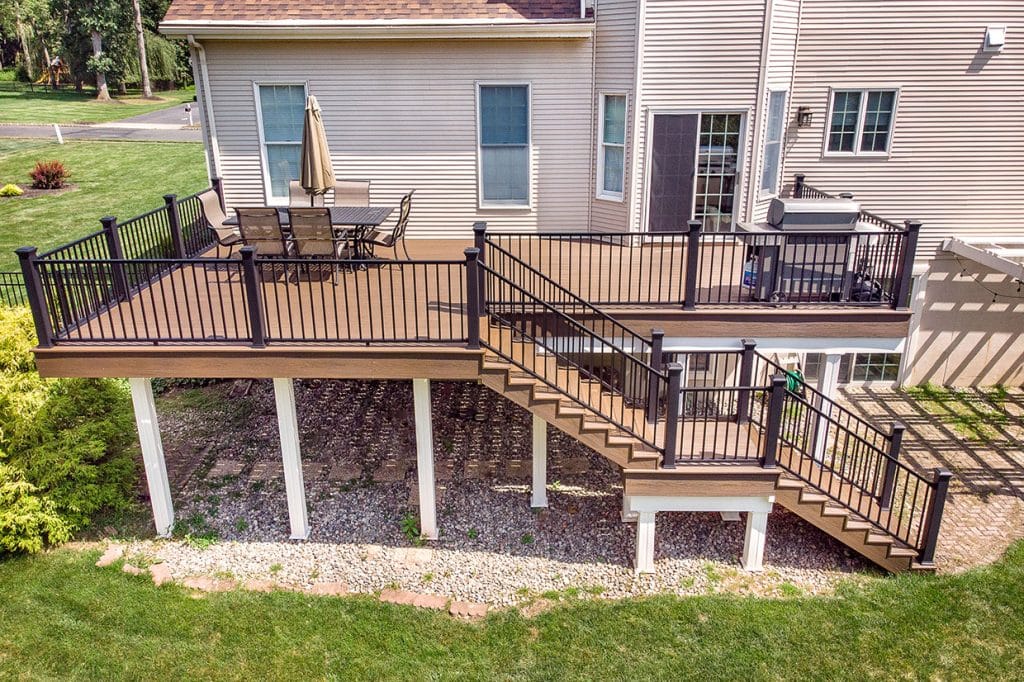Secrets to Durable Decks From Top-Rated Wood Deck Builders Contractors Near Me
Secrets to Durable Decks From Top-Rated Wood Deck Builders Contractors Near Me
Blog Article
Key Considerations to Guarantee Smooth Deck Installment on Your Residential Property
When you're intending to set up a deck on your building, several vital considerations can make all the distinction. You need to analyze your outdoor area and comprehend your specific demands. Picking the right materials is vital for both toughness and appearances. And do not forget local building codes-- they're more crucial than you may assume. Allow's explore what you should maintain in mind to assure a smooth setup procedure.
Analyzing Your Outdoor Area and Demands
Examine the layout of your yard-- take into consideration the sunlight's path, existing trees, and any type of slopes that may influence your layout. You'll likewise desire to inspect regional zoning regulations and HOA guidelines to guarantee conformity with any type of constraints.
Take into consideration just how much upkeep you're ready to dedicate to, as this will certainly affect your design choices. By plainly specifying your vision and needs, you'll establish a solid foundation for your deck installation task, assuring it improves your exterior experience and fits effortlessly into your lifestyle.
Selecting the Right Products for Longevity and Appearance
When it comes to choosing materials for your deck, you intend to balance resilience with visual appeals. Various material types can use special advantages, and the best style can boost your exterior room. Let's discover your alternatives to discover the excellent suitable for your needs.
Material Kind Comparison
Choosing the right materials for your deck is necessary, as it not just affects the framework's durability however additionally its total aesthetic appeal. You have a number of alternatives, each with its benefits and drawbacks. Pressure-treated lumber is a prominent choice for affordability and strength but requires normal upkeep. Compound materials blend timber fibers and plastic, providing durability and low maintenance, though they can be pricier. If you like natural aesthetic appeals, hardwoods like teak wood or mahogany provide magnificent looks and durability, but they commonly include a greater expense. Aluminum outdoor decking is incredibly sturdy and immune to weather, yet it may not match the traditional timber appearance. Consider your spending plan, upkeep preferences, and wanted lifespan when making your option.
Visual Style Options
While picking materials for your deck, it's essential to stabilize aesthetic appeals and sturdiness. You want a deck that looks wonderful however also stands up to the components.
Do not ignore color and texture; picking a stain or finish can improve your deck's visual appeal. Incorporate style components like barriers and lighting to enhance your chosen products. Ultimately, choose a design that shows your home's character while guaranteeing your deck remains practical and long-lasting.
Understanding Local Building Ordinance and Rules
Recognizing local building ordinance and guidelines is crucial, as these rules verify your deck is secure and compliant. Before beginning your task, you'll intend to check with your local building division. They'll give standards on products, dimensions, and structural needs particular to your area. These codes typically differ by place, so it's essential to know the specific laws that put on you.
You may need to get permits prior to building begins, which can include sending in-depth strategies of your deck. This procedure assurances your layout fulfills security criteria and zoning regulations. In addition, regulations may determine obstacle distances from building lines or existing frameworks.
Neglecting these codes can bring about costly fines or the requirement for modifications later on. Take the time to research study and recognize what's required in your location-- it'll save you frustrations down the line and validate your deck is constructed to last.
Proper Website Preparation and Preparation
Before you start constructing your deck, you need to assess the ground problems to guarantee a solid structure. Preparation the deck design is important for taking full advantage of room and capability, so take your time to design it thoughtfully. Don't forget to acquire the required permits to maintain whatever compliant with local guidelines.
Examining Ground Conditions
As you get ready for deck setup, evaluating ground problems is important to assure a steady and lasting framework. Start by inspecting the dirt type; sandy or loose soils might require additional support. Check for drainage problems, as standing water can threaten your deck's structure in time. If the ground is unequal, think about leveling it to offer a strong base for your deck. Look for any kind of obstructions like tree origins or large rocks that can hinder installation. Additionally, assess the distance of close-by frameworks, as this can influence your deck's layout and safety. By taking the time to extensively analyze these aspects, you'll lay a strong foundation for your deck, eventually ensuring its durability and performance.
Designing Deck Format
With a solid structure evaluated, you can currently focus on creating your deck format. Start by taking into consideration the function of your deck-- will it be for enjoyable, stress-free, or maybe both? A well-planned format sets the phase for a deck that enhances your residential property and meets your requirements.
Getting Essential Permits
As soon as you have actually picked your deck style, acquiring the necessary licenses is crucial to ensure conformity with regional regulations. Start by talking to your local building division to understand certain needs for your area. Some municipalities may have zoning laws, setback demands, or height constraints that you should comply with.
Collect the called for files like site plans, structural information, and sometimes try this website also engineering records. Do not forget to make up any type of homeowner association guidelines if suitable.
Sending your application precisely can conserve time and avoid potential hold-ups. As soon as you get the licenses, keep them accessible during the installation process. This means, you'll make certain everything stays above board and avoid any penalties or concerns down the line.
Working With Certified Specialists vs. Do It Yourself Setup
When deciding in between hiring certified professionals and tackling a DIY deck installation, you'll intend to evaluate your skills and sources against the complexity of the task. If you have experience with carpentry and a solid understanding of local building ordinance, a DIY strategy might conserve you money. Think about the time and effort needed.
On the other hand, hiring professionals can assure a high-grade setup. They have the know-how, tools, and knowledge to manage unanticipated difficulties, which can save you from pricey blunders. In addition, they can typically finish the job quicker than you may on your own.
Eventually, consider your readily available time, degree of know-how, and the intricacies of your deck layout. If the job feels overwhelming, spending in a qualified professional can offer peace of mind and a magnificently finished deck that meets security standards.
Budgeting for Your Deck Job
Before diving into your deck project, it's critical to establish a reasonable budget that covers all facets of the setup. Beginning by determining the materials you want to use-- wood, composite, or PVC-- each comes with various rate points. Consider labor prices if you're employing professionals, or consider the tools and materials required for a do it yourself method.
Don't fail to remember to include licenses and inspections, which can vary by place. It's wise to set apart an additional 10-15% for unforeseen costs that might arise throughout the procedure.
Lastly, think of any type of additionals, like railings, lighting, or furniture, that can improve your deck's capability and appearances. By producing an extensive spending plan, you'll guarantee you not only remain on track financially but also develop the outdoor room you have actually pictured.
Upkeep and Look After Long Life
To assure your deck continues to be in top problem for years to come, normal upkeep is vital. For wood decks, think about applying a timber cleaner and brightener to preserve the natural color.

Additionally, maintain the location around your deck clear of fallen leaves and debris. This not only improves visual appeals yet also stops wetness accumulation that can cause mold. By complying with these basic steps, you'll validate your deck stays stunning and functional for many years to find.
Regularly Asked Inquiries
What Is the very best Period for Deck Installment?
The most effective period for deck setup is springtime or early fall. Pleasant weather condition makes it easier to work, making certain materials adhere effectively. Plus, you'll enjoy your brand-new deck during the warmer months ahead.
How much time Does a Normal Deck Installment Take?
Deck installment normally takes one to 2 weeks, depending on dimension and intricacy. You'll desire to factor in weather and any essential permits, so intending ahead can help streamline the procedure considerably.
Can I Install a Deck on a Sloped Lawn?
Yes, you can mount a deck on a sloped lawn. You'll need to consider progressing, appropriate assistance frameworks, and drainage systems to ensure stability and check my source safety. With cautious preparation, it can be a gratifying project.

What Allows Are Needed for Deck Installment?
You'll likely require a building authorization for deck setup, depending on local guidelines. custom deck builders company near me. Get in touch with your city or region to verify requirements, as they can differ. Do not fail to remember to ask about zoning and safety codes also
Exactly how Do I Secure My Deck From Weather Damage?
To secure your deck from weather condition damage, frequently apply sealers, make use of weather-resistant products, and clean particles. Consider installing a roof or awning, and evaluate for wear to ensure longevity versus severe problems.
Report this page